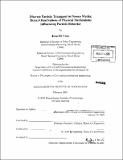| dc.contributor.advisor | Patricia J. Culligan and John T. Germaine. | en_US |
| dc.contributor.author | Yoon, Joon Sik, 1973- | en_US |
| dc.contributor.other | Massachusetts Institute of Technology. Dept. of Civil and Environmental Engineering. | en_US |
| dc.date.accessioned | 2008-02-28T16:05:20Z | |
| dc.date.available | 2008-02-28T16:05:20Z | |
| dc.date.copyright | 2005 | en_US |
| dc.date.issued | 2005 | en_US |
| dc.identifier.uri | http://dspace.mit.edu/handle/1721.1/30194 | en_US |
| dc.identifier.uri | http://hdl.handle.net/1721.1/30194 | |
| dc.description | Thesis (Ph. D.)--Massachusetts Institute of Technology, Dept. of Civil and Environmental Engineering, 2005. | en_US |
| dc.description | Page 362 blank. | en_US |
| dc.description | Includes bibliographical references. | en_US |
| dc.description.abstract | An understanding of how discrete particles in the micron to submicron range behave in porous media is important to a number of environmental problems. Discrete particle behavior in the interior of a porous medium is complex and influenced by various physical and chemical factors. This work aimed to provide new insight into the physical factors influencing discrete particle movement and attachment in a uniform, saturated porous medium. As part of this aim, a new technique for visualizing discrete particle transport in the interior of a porous medium has been developed. The technique, which includes the construction of a translucent medium and the use of laser induced fluorescence for particle tracking, was used to examine the behavior of a 50 mg/L suspension of negatively charged, micron-size, non-Brownian particles in the interior of a porous medium constructed from water saturated, mono-size 4mm diameter glass beads. Particle behavior as a function of pore fluid velocity and solid surface roughness was imaged at both the macroscopic and microscopic level. Experimental results revealed two interactions between the discrete particles and the solid phase of the medium. One, particle entrapment, resulted in the firm collection of particles at solid-solid contact points and asperities on the solid surfaces. The other, particle hindrance, resulted in non-firm interactions between the particles and the solid's contact points and surfaces. Both entrapment and hindrance were driven by gravity. Hence, the discrete particles were entrapped and hindered at the top surface of the glass beads comprising the medium, and at the upper portion of the contact points. | en_US |
| dc.description.abstract | (cont.) The entrapment mechanism was physical interlocking on surface roughness and physical straining at the contact points. Particle sedimentation and particle re-entrainment as a result of flow field perturbations were the main mechanisms contributing to the hindrance of particles. Changes in the concentrations of particles that were entrapped or hindered were observed with distance from the particle injection point. These changes, which became more significant as the fluid velocity decreased, were attributed to particle size distribution effects. Experiments conducted with an upward pore fluid velocity supported the hypothesis that particle entrapment and hindrance are driven by gravity. The comparison of the experimental results with particle transport models based on macroscopic mass balance equations demonstrated some of the short-comings of these models. Drainage tests performed using the geotechnical centrifuge and the new visualization technique e also provided initial insight into discrete particle behavior in an unsaturated porous medium. The results of these tests show that particles were scavenged by the air-water interface, adsorbed on the air-water interface of the pendular rings, and were retained by film straining. Thus, it is believed that the visualization technique developed during this work can be used to further investigations of discrete particle transport behavior in partially saturated porous media. | en_US |
| dc.description.statementofresponsibility | by Joon Sik Yoon. | en_US |
| dc.format.extent | 362 p. | en_US |
| dc.language.iso | eng | en_US |
| dc.publisher | Massachusetts Institute of Technology | en_US |
| dc.rights | M.I.T. theses are protected by copyright. They may be viewed from this source for any purpose, but reproduction or distribution in any format is prohibited without written permission. See provided URL for inquiries about permission. | en_US |
| dc.rights.uri | http://dspace.mit.edu/handle/1721.1/30194 | en_US |
| dc.rights.uri | http://dspace.mit.edu/handle/1721.1/7582 | |
| dc.subject | Civil and Environmental Engineering. | en_US |
| dc.title | Discrete particle transport in porous media : discrete observations of physical mechanisms influencing particle behavior | en_US |
| dc.type | Thesis | en_US |
| dc.description.degree | Ph.D. | en_US |
| dc.contributor.department | Massachusetts Institute of Technology. Department of Civil and Environmental Engineering | |
| dc.identifier.oclc | 60686715 | en_US |
